
Roan is a coat color found in many animals, including horses, cattle, antelope, cat and dogs. It is defined generally as an even mixture of white and pigmented hairs that do not "gray out" or fade as the animal ages. There are a variety of genetic conditions which produce the colors described as "roan" in various species.

The American Paint Horse is a breed of horse that combines both the conformational characteristics of a western stock horse with a pinto spotting pattern of white and dark coat colors. Developed from a base of spotted horses with Quarter Horse and Thoroughbred bloodlines, the American Paint Horse Association (APHA) breed registry is now one of the largest in North America. The registry allows some non-spotted animals to be registered as "Solid Paint Bred" and considers the American Paint Horse to be a horse breed with distinct characteristics, not merely a color breed.
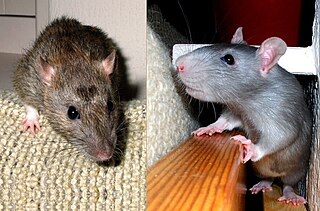
A dilution gene is any one of a number of genes that act to create a lighter coat color in living creatures. There are many examples of such genes:

Cat coat genetics determine the coloration, pattern, length, and texture of feline fur. The variations among cat coats are physical properties and should not be confused with cat breeds. A cat may display the coat of a certain breed without actually being that breed. For example, a Neva Masquerade could wear point coloration, the stereotypical coat of a Siamese.

A piebald or pied animal is one that has a pattern of unpigmented spots (white) on a pigmented background of hair, feathers or scales. Thus a piebald black and white dog is a black dog with white spots. The animal's skin under the white background is not pigmented.
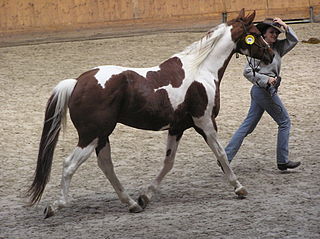
Skewbald is a colour pattern of horses. A skewbald horse has a coat made up of white patches on a non-black base coat, such as chestnut, bay, or any colour besides black coat. Skewbald horses which are bay and white are sometimes called tricoloured. These horses usually have pink skin under white markings and dark skin under non-white areas. Other than colour, it is similar in appearance to the piebald pattern. Some animals also exhibit colouration of the irises of the eye that match the surrounding skin. The underlying genetic cause is related to a condition known as leucism. The term is also used to describe spotting patterns in various other animals, such as goats.
At right is displayed the color traditionally called liver.
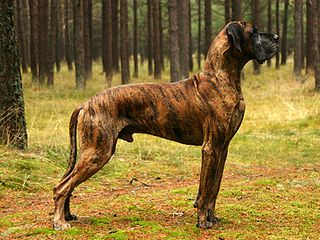
Brindle is a coat coloring pattern in animals, particularly dogs, cattle, guinea pigs, cats, and, rarely, horses. It is sometimes described as "tiger-striped", although the brindle pattern is more subtle than that of a tiger's coat.
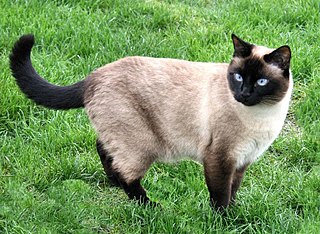
Point coloration is animal coat coloration with a pale body and relatively darker extremities, i.e. the face, ears, feet, tail, and scrotum. It is most recognized as the coloration of Siamese and related breeds of cat, but can be found in dogs, rabbits, rats, sheep, guinea pigs and horses as well.

Merle is a genetic pattern in a dog's coat and alleles of the PMEL gene. It results in different colors and patterns and can affect any coats. The allele creates mottled patches of color in a solid or piebald coat, blue or odd-colored eyes, and can affect skin pigment as well. Two types of colored patches generally appear in a merle coat: brown/liver and black. Associated breeds include Carea Leonés, Australian Shepherds and Catahoula Leopard Dogs. Health issues are more typical and more severe when two merle-patterned dogs are bred together.

The coat of the domestic dog refers to the hair that covers its body. Dogs demonstrate a wide range of coat colors, patterns, textures, and lengths.
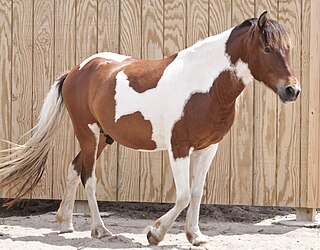
A pinto horse has a coat color that consists of large patches of white and any other color. The distinction between "pinto" and "solid" can be tenuous, as so-called "solid" horses frequently have areas of white hair. Various cultures throughout history appear to have selectively bred for pinto patterns.
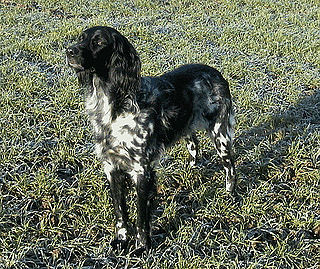
The Large Münsterländer is a breed of gun dog originally from the Münster region in Germany.

Chestnut is a hair coat color of horses consisting of a reddish-to-brown coat with a mane and tail the same or lighter in color than the coat. Chestnut is characterized by the absolute absence of true black hairs. It is one of the most common horse coat colors, seen in almost every breed of horse.

Horses exhibit a diverse array of coat colors and distinctive markings. A specialized vocabulary has evolved to describe them.

A calico cat is a domestic cat of any breed with a tri-color coat. The calico cat is most commonly thought of as being 25% to 75% white with large orange and black patches; however, they may have other colors in their patterns. Sometimes a variation occurs with cream and grey patches that is called a muted calico. Calicoes are almost exclusively female except under rare genetic conditions.
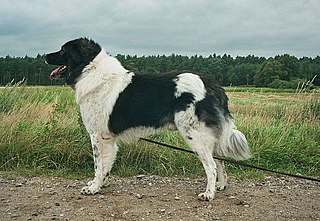
The Karakachan dog is a breed that originated from Bulgaria. It is related to the livestock guardian dogs of the surrounding countries: Romania to the north, North Macedonia and Serbia to the west, and Greece, and Turkey to the south. The dog is named after the Karakachans, Greek nomadic shepherds. Due to their conservative stock-breeding traditions, they have preserved some of the oldest breeds of domestic animals in Europe: the Karakachan sheep, Karakachan horse and the Karakachan dog. It is very similar to the Torniak dog, used by Vlach shepherds of Bosnia and Croatia.

The genetic basis of coat colour in the Labrador Retriever has been found to depend on several distinct genes. The interplay among these genes is used as an example of epistasis.

Dogs have a wide range of coat colors, patterns, textures and lengths. Dog coat color is governed by how genes are passed from dogs to their puppies and how those genes are expressed in each dog. Dogs have about 19,000 genes in their genome but only a handful affect the physical variations in their coats. Most genes come in pairs, one being from the dog's mother and one being from its father. Genes of interest have more than one expression of an allele. Usually only one, or a small number of alleles exist for each gene. In any one gene locus a dog will either be homozygous where the gene is made of two identical alleles or heterozygous where the gene is made of two different alleles.
The agouti gene, the Agouti-signaling protein (ASIP) is responsible for variations in color in many species. Agouti works with extension to regulate the color of melanin which is produced in hairs. The agouti protein causes red to yellow pheomelanin to be produced, while the competing molecule α-MSH signals production of brown to black eumelanin. In wildtype mice, alternating cycles of agouti and α-MSH production cause agouti coloration. Each hair has bands of yellow which grew during agouti production, and black which grew during α-MSH production. Wildtype mice also have light-colored bellies. The hairs there are a creamy color the whole length because the agouti protein was produced the whole time the hairs were growing.




















